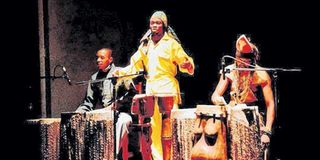Blending tradition with creativity

Part of the performances at the Haba na Haba dance festival. PHOTO | FILE
What you need to know:
Most have settled for what everybody has to offer with very little time and creativity attached the choreograpgic elements which are key to any such performances.
Dar es Salaam. Traditional and contemporary dances in Tanzania have for a long time lacked a platform to showcase the wealth that the country has in this genre in an industry that employs hundreds of thousands.
Most have settled for what everybody has to offer with very little time and creativity attached the choreograpgic elements which are key to any such performances.
In 2010 after Isaack Abeneko returned from Senegal, he and his former band members at Lumumba Theatre started free workshops on the subjects, it was at thses discussions that the value, goals and training of African contemporary dance, and methods came up.
Contemporary dance is a genre of dance performance that developed during the mid 20th century and has since grown to become one of the dominant genres for formally trained dancers throughout the world, with particularly strong popularity in the US and Europe.
It was through the influences that he had gathered in Senegal that convinced Isaack Abeneko to start a traditional and contemporary dance festival in Tanzania which he aptly named Haba na Haba.
Abeneko is a contemporary live performer, actor, dancer, guitarist and choreographer.
His music is delivered from various Tanzanian traditional dances, melodies and rhythms, blended with contemporary dance music to illuminate and inspire the next generation.
Speaking to The Beat, Haba na Haba as the artstic director Abeneko says, soon after he came from Dakar he shared what he had learnt there with Lumumba Theatre group. “With Lumumba Theatre Group we started with street presentations where by different people were trained on traditional and contemporary dance until when we found it ideal to start Haba na Haba festival in 2017,” says Abeneko.
He says, the main objective of coming up with the Haba na Haba festival was to provide contemporary dance performances in both indoor and outdoor spaces, reaching new audiences in the local community, and increase the value of contemporary dance as well as providing professional training to local dancers.
The festival which takes place indoors brings together great traditional and contemporary dance performances from a number of different groups from local and international artists and dance groups.
He says, Haba na Haba is a free event which gives a two weeks intensive dance workshop for beginers and advanced before workshop days and later followed up by two days of performances.
Commenting on the festival line up the Haba na Haba managing director Shabani Mugado says, the dance performances preceded by a line up of visual art activities including Children’s Art Classes.
The line-up included ChapChap Nature Body Painting, A Public Art Workshop which used the body as a canvas to create beautiful works of art inspired by nature, and the highlight of the night, Mama and Home Exhibition which was opened by Resident artist Walter Simbo Urasa.
He says a total of 13 groups performed at the festival. The grouops were 21st century, Chemli shine dance (Tanzania), Face Off by Ibuka dance foundation (Tanzania), You are welcome to stand at my place (Rwanda/Tanzania), White Wolf by DDI (Tanzania), Nyarero cultural group (Rwanda/Tanzania), Msimamo dance group (Tanzania), Mwili katika nyakati za mwisho by Yolanda Gutiérrez, The fabric of the universe by Benedetta Reuter (Germany/Italy), My white painting by Aloyce Makonde(Tanzania), Inside out by Samuel Ekeh (Lagos) and Shout by Nantea dance company.
On the first night six groups presented including Chemli, Face off and Nyarero cultural group rocked the indoors stage.
Chemli brought a story about how many people around the world have no idea what opportunities are around them and how they should be grateful and closer to them when they reach at their work place.
Shine dance Tz brought legendary story with traditional dance and songs from Tanzanian tribes with contemporary dance and bright light called Chemli (Chalwyn lamp).
Face off looked into the different faces we pick just so us to fit into society. We are required to talk, dress and behave in certain ways without which we become outcasts.
These labels according to them become part of our many identities and without them we tend not to function properly.
Face off brought a story of how often we find ourselves assuming different characters in our daily lives in order to be able to fit in society.
We are shaped and programmed so we find ourselves wearing one face to ourselves and another to the public but eventually we give into what might be the truth.
Haidary Chumambili is a group leader of Shine dance Tanzania. Commenting on the festival he says, he is happy that soon after their performance he got an opportunity of exchanging mobile numbers with different people in the musici indusrty.
“It was a very good opportunity for me and the group to show our work to the audience. However I would call upon organizers to add more of traditional groups and bring a balance between contemporary dance and traditional groups,” says Chumambili.




